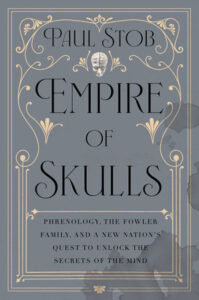Paul Stob
PAUL STOB is Director of the Program in American Studies at Vanderbilt University, where he also teaches in the Department of Communication Studies and the Program in the Communication of Science and Technology. His research and teaching focus on American intellectual culture in the nineteenth century, with an emphasis on the connection between reading, writing, and lecturing as well as religion, democracy, populism, and social movements. He is co-author (with Stephen Lucas) of The Art of Public Speaking (McGraw-Hill), which is now in its fourteenth edition and sells well over 100K copies a year in various print and electronic editions. Empire of Skulls is his first trade book.
Subscribe to our newsletter for news & events from Counterpoint Press.
Books
Empire of Skulls
This fascinating history of phrenology reveals how one family, despite their flawed framework, helped shape early understanding of the human mind—reflecting both the limits of early science and the ongoing evolution of scientific inquiryFor readers of The Immortal Life of Henrietta Lacks, The Emperor
of All Maladies, and Radium Girls
Today, everyone remembers phrenology—the study of the formation of the skull as indicative of mental faculties and traits of character—as pseudoscientific at best and racist at worst. And it most certainly contains elements of both. But, as author Paul Stob presents in Empire of Skulls, phrenology also has the unique distinction of marking the birth of the self-help movement, right alongside the birth of our country.
The science of phrenology was premised on a simple yet revolutionary idea: The bumps, spans, and masses on your head mirror those on your brain, and they are the keys to your past, present, and future. Discovered in Europe in the late-eighteenth century and promulgated across the U.S. in the decades before the Civil War, phrenology captured the imagination of millions of Americans thanks largely to the efforts of one family: the Fowlers.
Viewing the science as essential to personal and social advancement, siblings Orson, Lorenzo, and Charlotte Fowler set about transforming American life by unlocking the secrets of skulls. Year after year, the Fowlers:
- Delivered lectures from Maine to the Great Plains
- Performed hundreds of thousands of hands-on character examinations
- Created a wildly popular tourist attraction, the Phrenological Cabinet, in New York City
- Established a preeminent publishing firm, Fowlers and Wells
- And they examined the heads of the full range of humans—pirates, murderers, rapists, thieves, prisoners, and the insane, as well as presidents, statesmen, inventors, activists, writers, artists, and, most importantly, ordinary Americans
These efforts led first to a profitable business, then to a cultural movement, and finally to an empire of influence—one built on the promises and perils of human skulls. Though their names are seldom remembered today, this entertaining and absorbing read shows how their empire reshaped American life at a pivotal time in the nation’s history.

Catapult | Counterpoint | Soft Skull
20 Jay Street #704
Brooklyn, NY 11201
646.926.0805 | contact@catapult.co





